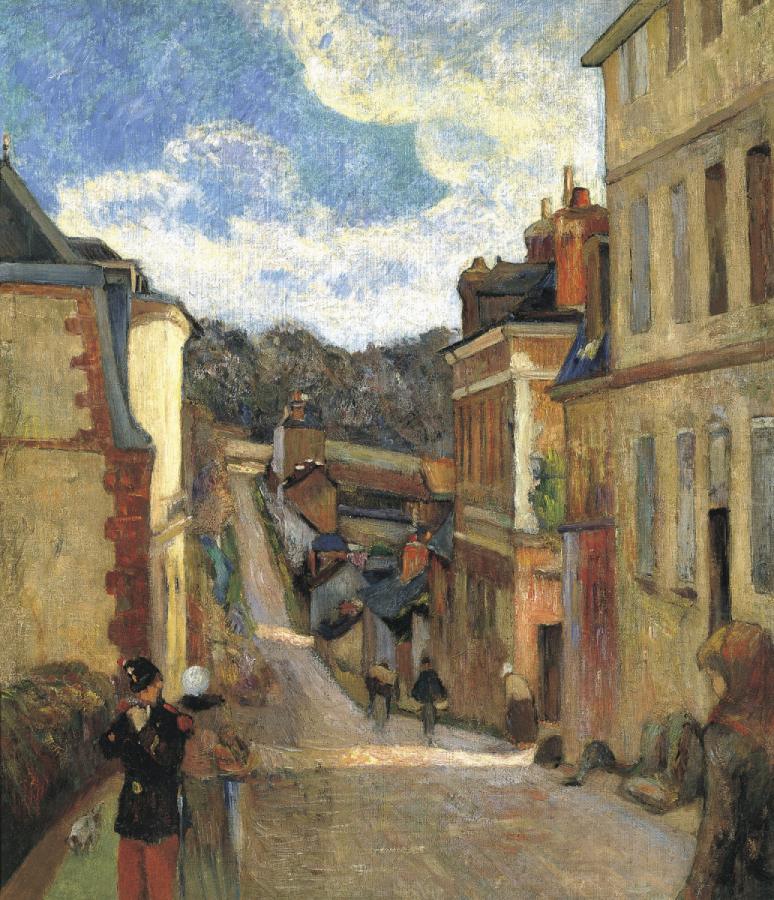Gauguin, Paul (1848-1903)
La rue Jouvenet à Rouen (Rue Jouvenet in Rouen)
1884
Oil on canvas, 55 x 48.5 cm
Museo Thyssen-Bornemisza, Madrid
©Carmen Thyssen Collection
This quiet street, similar to that of a village, represents the rue Jouvenet in Rouen, situated close to the impasse Malherne, where Gauguin settled with his family in 1884.
In 1883 various reasons had made the artist decide to move to Rouen, where Pissarro, who had guided him in his approach to impressionism, was living at the time. Gauguin had just lost his job, and had decided, at the age of thirty-five and already the father of five children, to dedicate himself entirely to his art. Life in the capital was too expensive to keep his family, and Gauguin also hoped, by moving to Rouen, to find a new clientele for his paintings. “Gauguin hopes, by isolating himself-wrote Pissarro to the collector Eugène Murer-to establish his career, and he counts on his friends and acquaintances to help him capture the favours of art lovers […]”.
During his ten-month stay, he made about forty paintings, essentially views of the town and its surroundings. In this urban view, probably painted in spring 1884, he remained faithful to his model from a topographical point of view, as can be seen from the almost unchanged aspect of the rue Jouvenet today, with its little houses aligned along the street. To liven up this banal scenery, the artist played on the succession of the warm and cold colours of the façade renderings, and on the rhythmic alternation of brightly lit areas with shaded zones. The composition is built around the street which descends and then rises again in the horizon. Along this line, Gauguin placed some figures, among which are a soldier in bright red trousers and even a small dog, which liven up and punctuate the long perspective of the street. The silhouettes in the foreground, cut out in an arbitrary manner, seem caught on the spot, but they were probably added to the scene, a technique which was habitually used by the artist.
In that period Gauguin was aware of the fact that he had not entirely mastered his art, but he generally carried out his experiments by painting from nature, trying to achieve a synthesis between Pissarro‘s Impressionism and Cézanne‘s more synthetic art. Around mid-May 1884 he wrote to Pissarro: “What I have at home at the moment is better in that sense, and what I’m hoping to do are large and not monotonous pieces, although I believe that nature is simple in its whole. To convey one’s thoughts one has to be sure of their execution and I have not yet found in this one what I what to do-I will have to suffer a little longer”. The picture is painted with quick brushstrokes, clearly visible, particularly in the sky, and become more regular on the façades of the buildings. The motifs are outlined with a darker trait, which emphasises the shapes. The drawing as well as the colours structure the composition, which is still dependant on the naturalistic vision of space typical of the Impressionists.
Mette Gauguin took the painting to Denmark when she separated from her husband. It was kept in the Rohde collection for a long time, and was later sold in London, Paris and New York, before being bought by Carmen Thyssen-Bornemisza in 1998.
Isabelle Cahn (T-B)
